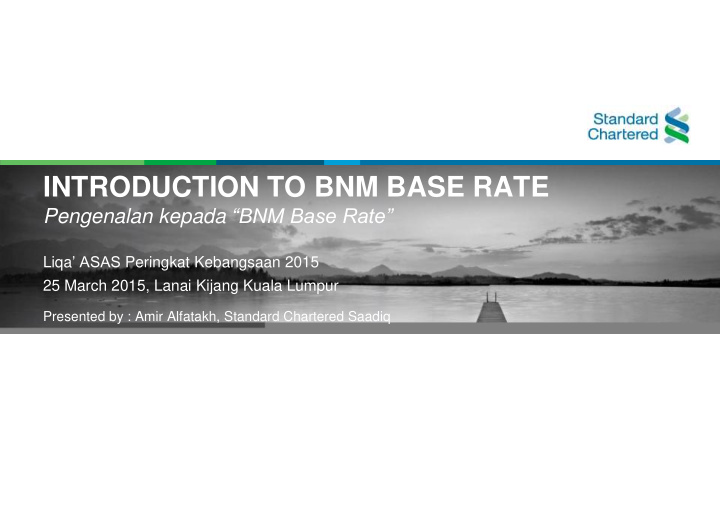



INTRODUCTION TO BNM BASE RATE Pengenalan kepada “BNM Base Rate” Liqa ’ ASAS Peringkat Kebangsaan 2015 25 March 2015, Lanai Kijang Kuala Lumpur Presented by : Amir Alfatakh, Standard Chartered Saadiq
Contents 1. Key Extract from the Reference Rate Framework 2. Summary Points for Base Rate 3. Base Rate Methodology – Saadiq Malaysia 4. Illustration : Financing Effective Rate of 4.85% p.a. 5. Potential Shariah Concerns 6. Conclusion 1
Key Extract from the Reference Rate Framework 2
Summary Points for Base Rate BR TO REPLACE BFR 1 Base Rate is meant to be more transparent and meaningful to Clients CLEAR COMPONENTS 2 Only Bank’s benchmark Cost of Funds and Statutory Reserve Requirement are the allowed components to BR. No hidden costs COMPETITIVE 3 Banks can offer a lower BR if they have cheaper Cost of Funds and/or more efficient in their fund management or risk management. Banks have full control of pricing RISK INFORMED PRICING 4 The Bank’s Spread (margin) can cater for customers with different risk profile , with higher pricing for higher risks. All risk related pricing is agreed up-front RISK ADJUSTED PORTFOLIO 5 Throughout the course of financing, Bank can adjust the Bank’s margin to meet increased risk from the customer (change in creditworthiness – defined as default). IMMEDIATE CHANGE 6 Instalments are immediately adjusted to cater for pricing change (default option)
Base Rate Methodology – Saadiq Malaysia Approach Benchmark 1. The Bank will not calculate “Actual” cost of funds Cost of 3.50% 3M KLIBOR (usually combination of low-cost deposits, interbank Funds borrowings and capital). 12M Average KLIBOR x Base Rate SRR costs 0.15% Statutory Reserve Requirement (SRR) 1. Base Rate to be determined by each Bank, and can only be revised if there is an OPR (Overnight Base Rate (BR) 3.65% Placement Rate) movement. Computed in consideration Spread over 1.20% of: BR* 2. Benchmark Base Rate is proposed to be the 3M KLIBOR rates. Rationale – the 3M KLIBOR closely 1) Credit Risk 2) Liquidity Risk Premiums tracks the OPR on a 1-2 months lag basis. 3) Operating Costs 4) Profit Margins 3. Proposed SRR costs is based on average 12 months 5) Others KLIBOR (12 months / 2) *cannot be changed except Spread over Base Rate (Margin) due to change in creditworthiness of the 1. The Spread over BR is the Bank’s expected operating customer costs, risk costs and margin. The minimum AVERAGE Spread over BR is expected to be 1.10% (at Bank Customer Rate 4.85% wide level). 2. This spread maybe adjusted based on the risk profile Saadiq has adopted the same of an individual customer i.e. Change in customer’s creditworthiness or risk profile methodology as the parent bank for its benchmark
Illustration : Financing Effective Rate of 4.85% p.a. Now : Base Financing Rate @ 6.85% p.a. Jan 2015 : Base Rate @ 3.65% p.a. Bank’s • Bank’s Risk Spread & • Bank’s Risk Margin Income Spread & Income Bank’s (-2.00% p.a.) • Liquidity Margin Reserves • Credit Risk Premium (+1.20% p.a.) • Operational Risk • Cost of Funds (Costs) • Statutory Base Requirements Reserves Financing • Liquidity Reserves Rate • Credit Risk • Cost of Funds Base Rate Premium (6.85% p.a.) • Statutory Requirements • Operational Risk (3.65% p.a.) Reserves (Costs) 5
Potential Shariah Concerns Change in Spread over BR Adjustment of Instalment Risk-informed Pricing for on change of customer’s Amount instead of Extension the BR Creditworthiness of tenure on Pricing change • Customers will be evaluated • The Framework allows for the • For any revision in the pricing based on their creditworthiness Bank to revise the Spread over (BR revision or Bank Spread and track record by the Bank. BR according to change in the revision), the Bank will revise customer’s risk profile or the Instalment Amount creditworthiness during the accordingly (default option) • The credit risk rating will financing tenure determine the ultimate pricing • This will ultimately increase the quoted to the customer. • Customers are not required to monthly commitment of the explicitly “accept” the change in customer during pricing change. • A customer with a good track Bank spread. record will obtain better pricing. • It is discouraged to extend the • There is no pricing cap outlined tenure of the financing • A customer with marginal track for such revision (discretionary). automatically, unless by specific records will be quoted a “risk - request. informed” pricing to mitigate potential defaults. • Concerns : This can be • Concerns: This will result in • Concerns : Marginal customers construed as a punitive pricing revision, on top of the Late additional burden to customers, will incur a higher pricing to cater for the perceived “higher Payment Charges (LPC), and especially revisions due to risks”. become an additional burden. creditworthiness. 6
Conclusion – Emphasis on Risks PRICING STRATEGIES 1 Base Rate means greater transparency closely tied to actual COF. Risk pricing built into Bank’s Spread must be “accurate” to cater for future customer risks, especially long-term products to ensure margins are maintained TRANSFER OF RISKS 2 Pricing adjustments allowed to cater for changes in credit worthiness aimed to protect bank from risk (risk-transfer) rather than consumers (risk-sharing) SHARIAH VIEW 3 Risk becoming important component in international standards e.g. Risk Informed Pricing and Basel requirements on Risks and Capital to ensure stability and endurance of financial institution. Shariah view on risks and impact on customer is not clear
Recommend
More recommend